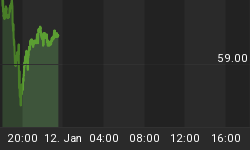It is no longer a matter of whether or not you should buy gold and/or silver but, rather, which type of investment(s) and how much. You don't need a lot but you do need some - and here is a primer on just what type of investment vehicles are available and recommendations on just how much you should buy.
Gold is the best hedge against uncertainty there is and it is also a useful thing to have in your portfolio if inflation is rising, as some foresee, or if the U.S. dollar were to decline further, as expected. Don't take my word for it but instead read this[1] article identifying 87 gold analysts who think the environment is such that the price of gold will go parabolic to $5,000 or more!
How Much Gold Do You Need?
The U.S. firm Ibbotson Associates, in a study for Canada's Bullion Management Group, found investors can potentially improve their balance of risk and reward with a precious metals weighting of 7.1 per cent in conservative accounts, 12.5 per cent in moderate accounts and 15.7 per cent in aggressive accounts. Precious metals can include silver and platinum, but it's a term that primarily means gold.
Another U.S. firm, Wainwright & Co. Economics Inc., looked at the need for gold in one's portfolio from an inflation protection point of view and concluded from their research (see [2] that "a U.S. equities portfolio in which 15% of the assets are diverted to gold bullion would be effectively immune from damage due to a rising gold price and that is, we believe, equivalent to immunity from inflation."
Which Vehicle Should You Choose?
a) Physical Gold and Silver
Gold in bars or coins makes sense if you are concerned about the complete breakdown of society but you will have an asset that needs to be securely stored. Read this[3] article with suggestions on how to go about buying and storing physical gold and this[4] article on why silver looks to have even greater upside potential than gold.
b) Individual Gold and Silver Stocks and/or Their Long-term Warrants
Gold and silver stocks have an added degree of risk because you not only need gold prices to rise (and gold stocks and gold bullion don't always move in unison) but you also need your precious metals company to be a well-run business. For greater leverage on your invested dollars consideration should be given to an investment in commodity-related long-term warrants. This[5] article spells out the details on currently available warrants that warrant your consideration.
c) Precious Metals Mining Mutual Funds
PM funds hold the stocks and/or warrants of gold, silver and platinum companies involved in the producing, developing, exploring or buying (via royalty payment arrangements) of such metals. While they are among the most expensive in terms of the fees they charge they have a long history of bringing the benefit of rising gold prices to individual investors (and the opposite, of course). Go here[6] for specific stock and mutual fund recommendations.
d) Exchange-traded Funds
There are two kinds of gold ETFs:
1. One tracks the price of gold bullion and is thus a clean, convenient proxy for holding physical gold. Go here[7] for a primer on these types of ETFs offered for sale in Canada and the U.S.
2. The other tracks an index of gold mining stocks such as those in the S&P/TSX Global Gold Index and the large-cap and mid-cap producers in the AMEX Gold Miners Index. For more information read this[8] article.
e) Closed-end Funds
Closed-end funds are conventional mutual funds that trade like a stock and thus can be bought or sold any time during the trading day (mutual funds can only be sold at end-of-day prices). Closed-end funds differ from ETFs in that they can trade at significant discounts or premiums to the net asset value, whereas ETFs will veer away from their net asset value only temporarily and mildly. Some closed end funds invest in the stocks of precious metals mining companies while others offer a way to hold actual gold. For more details on this subject read this article[9].
Two key questions to ask:
1. Am I investing in gold stocks or gold bullion?
2. Am I exposed to Canada-U.S. currency fluctuations?
Remember, gold is priced in U.S. dollars and a rising Canadian dollar will undercut your gains. This won't be a problem if you own a precious metals fund that holds TSX-listed gold stocks, but it might be if you have a fund tracking gold bullion prices.
f) Gold and Silver Coins
Owning gold and silver coins are another alternative to consider and this[10] article advises you of the pros and cons of doing so and the types of coins available and preferred.
Conclusion
Gold's rise to $1,500 per ozt. and beyond (For an excellent article on the significance of the designation of ozt. go here[11]) has created a lot of excitement and raised expectations of more gains to come but the reason why gold's a legitimate asset class for investors today is its potential to shine when all else is bleak.
In conclusion, how much gold and/or silver do you have in your portfolio?
Original Source: http://www.munknee.com/2011/05/which-gold-investment-should-you-buy-and-how-much/
Notes:
[1] Take Note: These Analysts Believe Gold Will Go to $5,000 - or More!
[2] How Much Gold Bullion Should You Have In Your Portfolio?
[3] Rules to Follow When Buying Physical Gold
[4] Why Silver at $398.52 is a Realistic Parabolic Peak Price
[5] The "Secret" World of Gold & Silver Company Warrants
[6] Why Gold Could Go To $5,000 - and How To Capitalize On It!
[7] Gold Bullion ETFs: A Primer
[8] GDXJ: A Small-Cap Gold Miner ETF With Big Potential
[9] Buying gold: An investor's guide
[10] The Pros and Cons of Buying Gold Bars, Ingots and Coins
[11] What's the Difference Between 1 Gold Karat, 1 Diamond Carat and 1 Troy Ounce?















